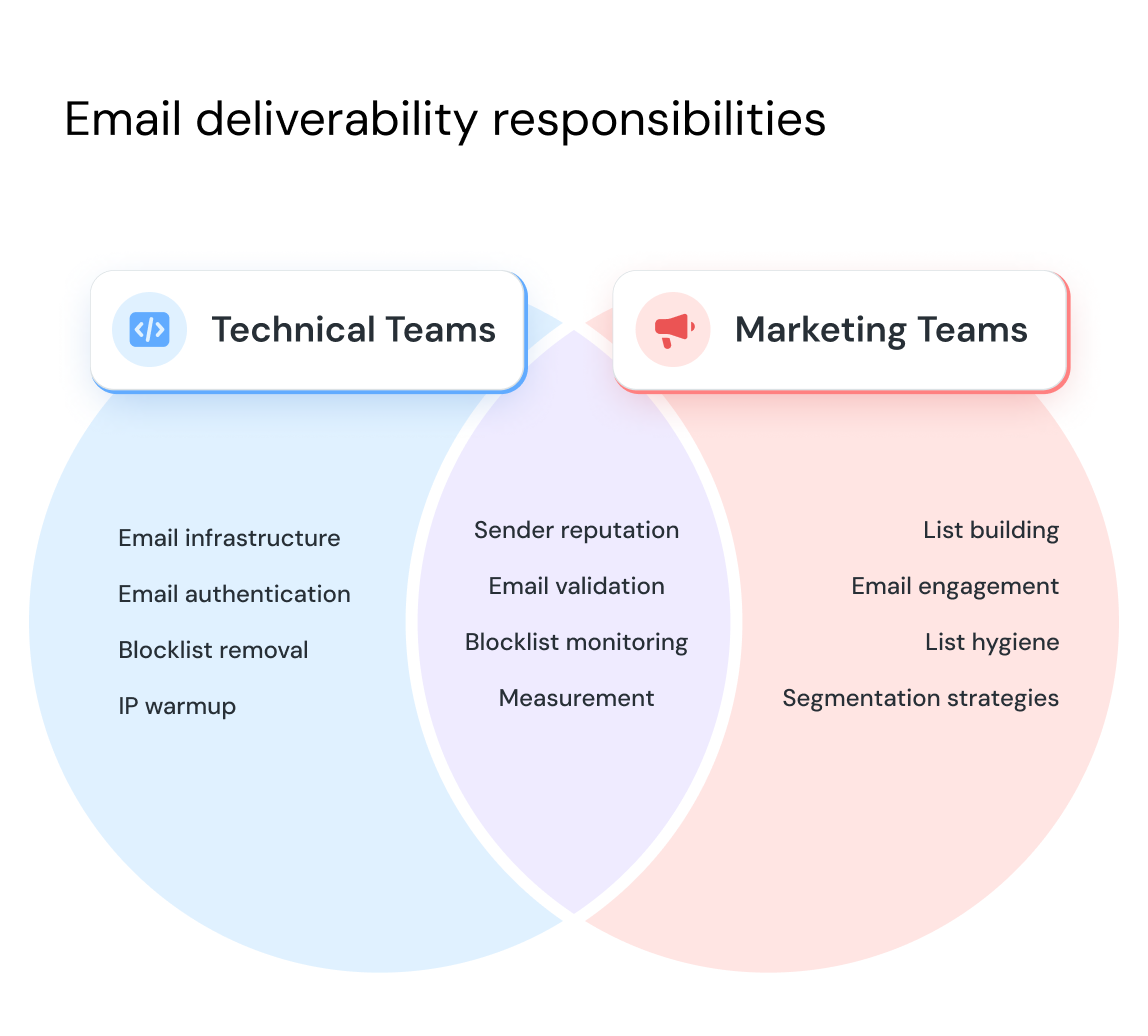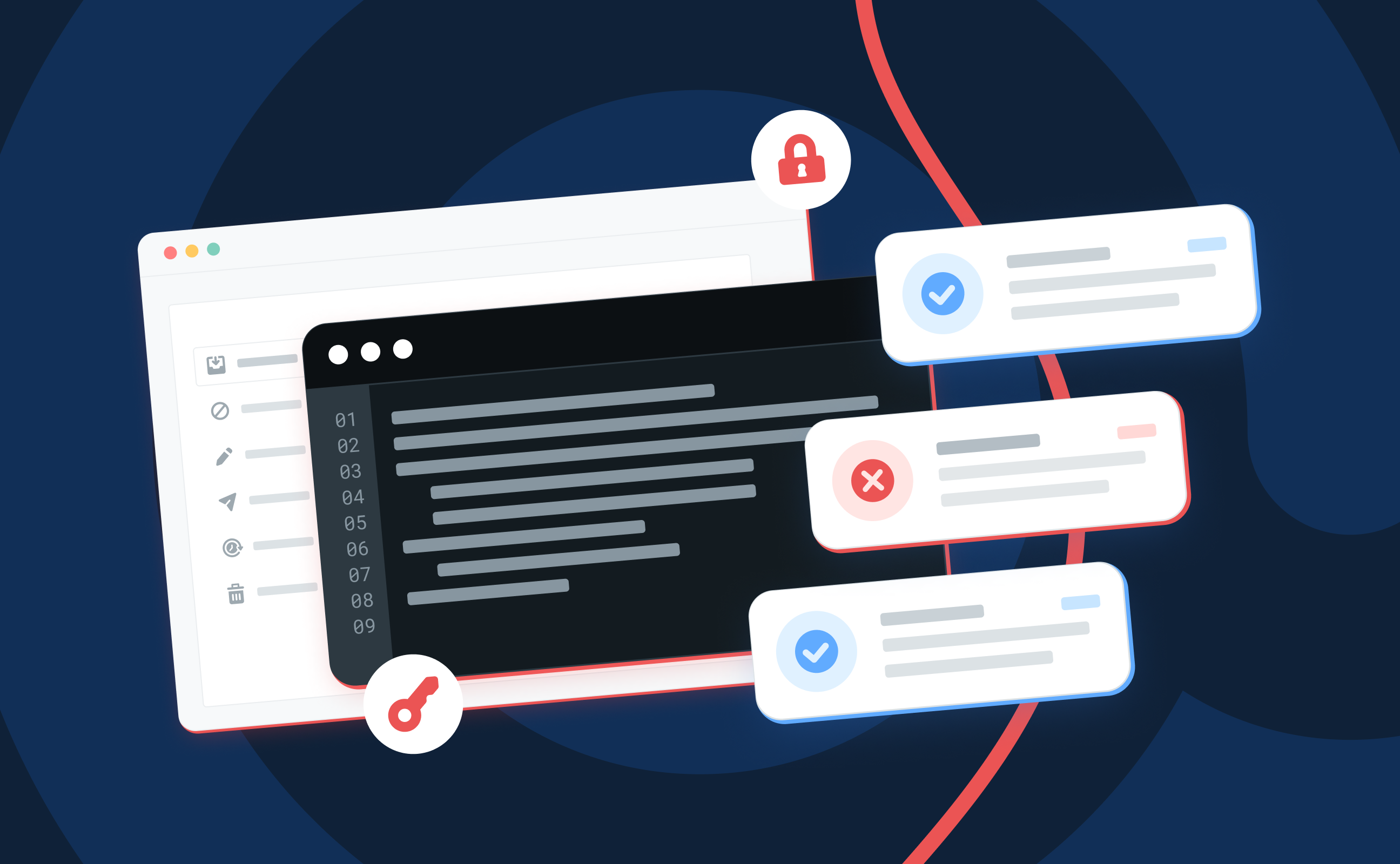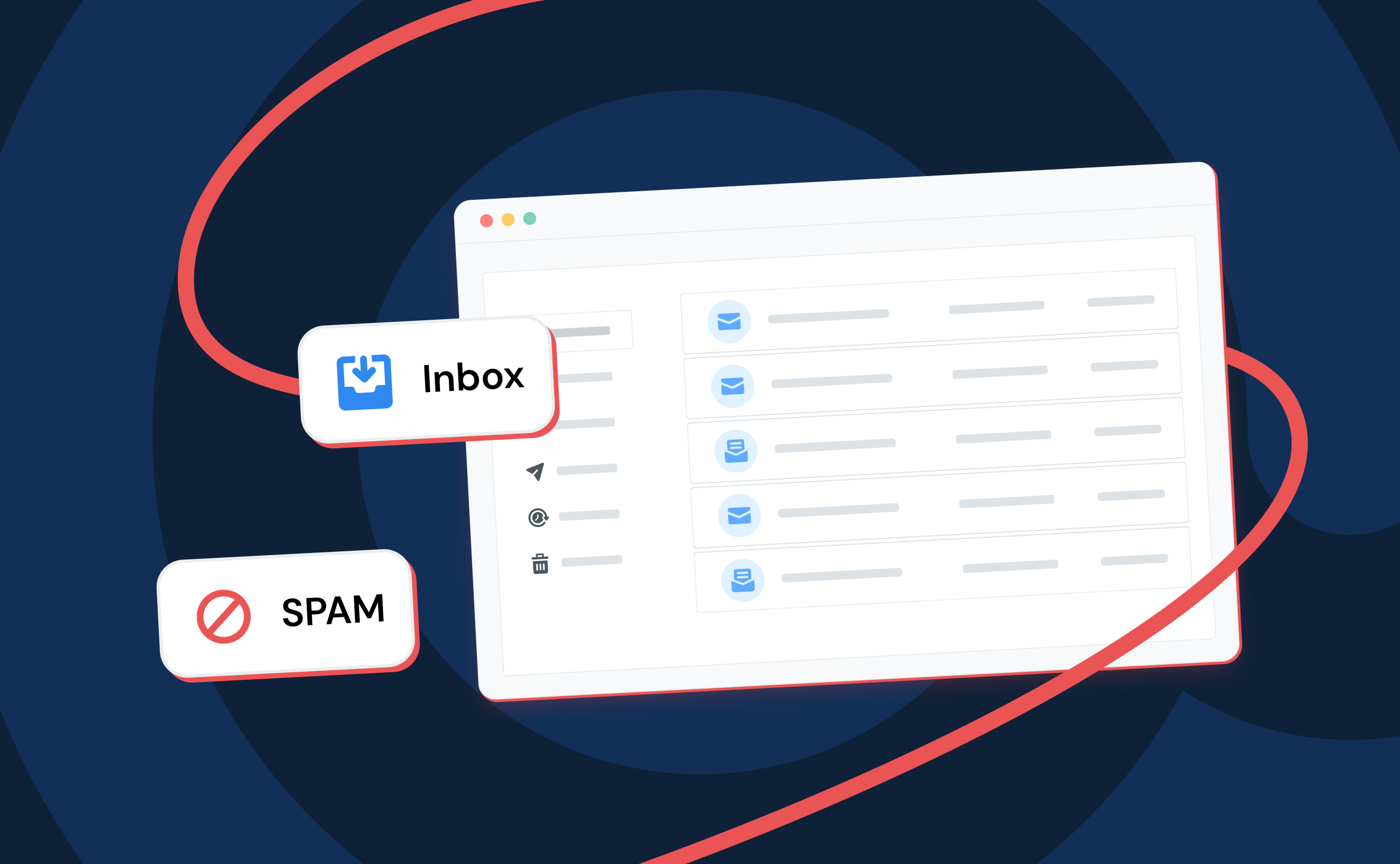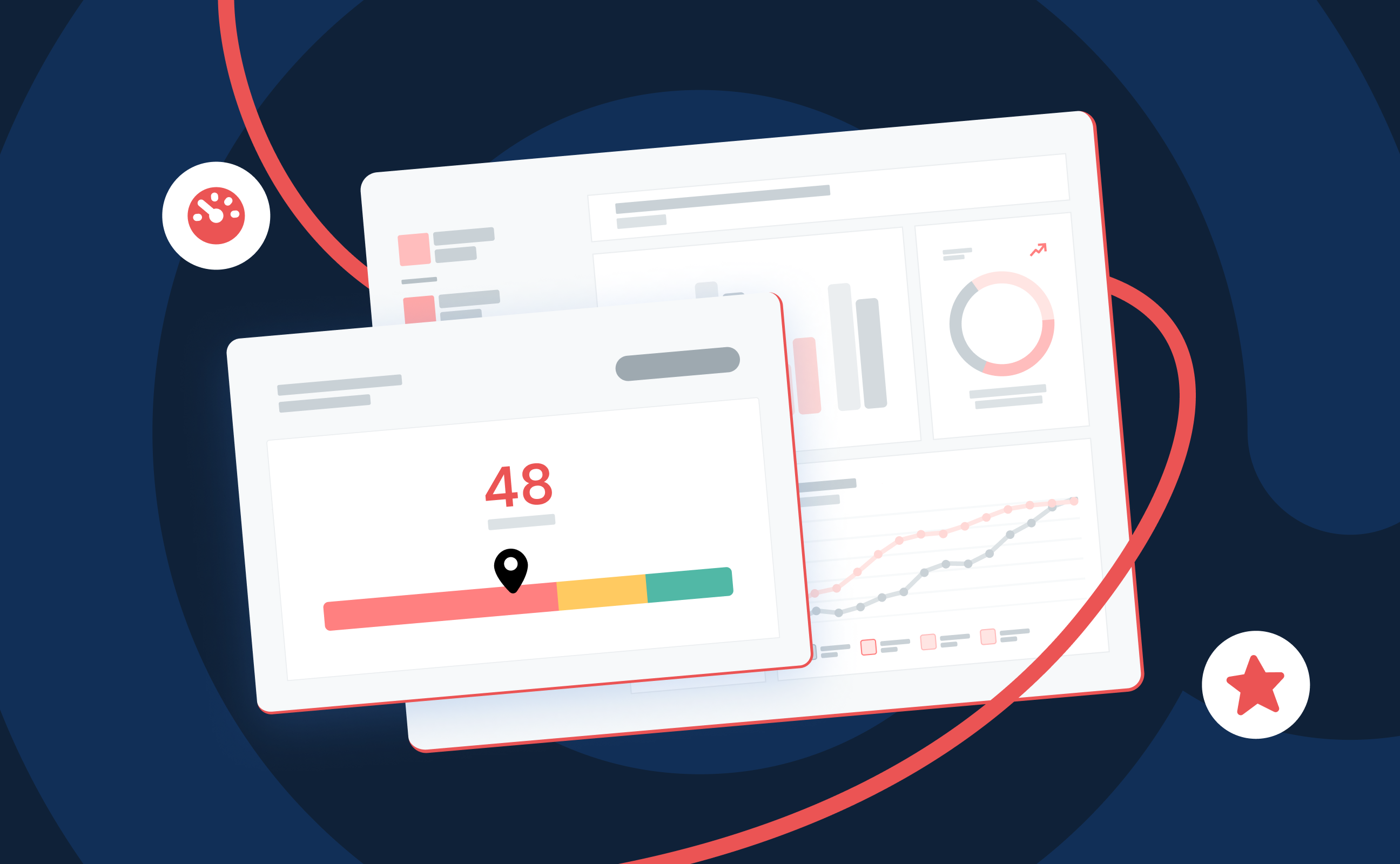Chapter 6
How to improve email deliverability
Why is achieving inbox placement a top priority for many organizations? Because email is directly connected to the customer experience. Get actionable advice to improve email deliverability and resources to learn more.

Share to
State of email deliverability 2025
The year of Yahoogle
Email authentication in 2025
Understanding inbox placement
Email list building and hygiene
Email sender reputation
How to improve email deliverability
Key findings on improving email deliverability
The importance of reaching the inbox
The benefits of prioritizing deliverability
Who is responsible for email deliverability?
How to improve email deliverability and sender reputation
Final thoughts on improving email deliverability in 2025
About this survey
PUBLISHED ON
Email is a very dependable channel for marketing and communications in many organizations. It’s easy to dismiss the need to improve email deliverability because you may simply expect everything to work. But what if delivery of your emails was disrupted? How would that impact day-to-day aspects of the business?
Deliverability is a lot like personal health. You can wait for problems to show up and address the symptoms, or you can take preventive steps to stay in good shape.
Let’s wrap up Sinch Mailgun’s State of email deliverability 2025 with some insights into the importance of deliverability and reminders to help you stay on the right side of the inbox.
Table of contents
1. Email infrastructure and technology
3. Email engagement levels
4. List building and hygiene
Key findings on improving email deliverability
.%
of senders say good email deliverability is important to their organizations.
%
of senders believe prioritizing email deliverability benefits the customer experience.
%
of senders say they’re very confident in their knowledge of email deliverability.
%
of senders say both technical and marketing teams are responsible for email deliverability.
The importance of reaching the inbox
We asked senders to rate the importance of achieving good email deliverability from 1 to 10. It’s clear that most see it as a priority. 78.5% of respondents rated the importance of email deliverability between 8 and 10. In fact, 46% gave it a solid 10. We’d say that’s pretty important.
Using a scale of 0 - 10, rate the importance of good email deliverability to your organization
The size of the organization and the volume of email had little to do with the level of perceived importance. But if reaching the inbox is so vital, many senders could do more to improve deliverability.
Consider these key findings from Sinch Mailgun’s original research:
%
of senders do not use inbox placement testing to measure deliverability.
%
of senders are not monitoring their reputation with Google Postmaster Tools.
%
of senders do not actively monitor major email blocklists for their IP/domain.
%
of senders rarely or never conduct email list hygiene.
Is your organization one that needs to step up its investment in email? How much more effective could this channel be if you worked to improve email deliverability?
The benefits of prioritizing deliverability
Need some good reasons to put email deliverability higher on your priority list? We asked senders who rated the importance of deliverability highly about the biggest benefits of achieving inbox placement.
Two factors related to the customer experience emerged as most beneficial: Reliable customer communication (29.5%) and Improved customer satisfaction (15.8%).
What do you believe is the biggest benefit with prioritizing email deliverability and inbox placement?
Around 10% of senders believe the biggest benefit of good deliverability is Increased revenue from email, and about the same percentage feel that way about getting a Return on marketing efforts (9.7%).
This makes a lot of sense for email marketers. You can’t boost sales with promotional emails if they fail to reach the inbox. And while the ROI of email is notably high, that’s only true when your messages reach subscribers.
Transactional emails may not drive revenue, but they are just as important as any marketing campaign. Sinch Mailgun research found 71% of consumers would check their spam folder if a transactional message didn’t show up in their inbox. (Another 16% would check spam if the message was important.)
But ending up in junk is not a good look. That’s like making your subscribers dig through a garbage bin for a piece of missing mail. As we’ve noted, this can cause contacts to lose trust or unsubscribe. When we asked senders to choose the biggest problem with landing in spam, Damage to brand reputation (15.9%) was second only to People miss important information (37.5%)
What do you believe is the biggest problem with your emails landing in spam?
Upset customers/contacts (13.4%) took the third spot. And as with the benefits of good deliverability, around 10% of senders cited reduced revenue and wasted marketing resources as downsides of landing in spam.
Who is responsible for email deliverability?
The people who took our survey come from a wide range of industries and job roles. Respondents included small business owners and C-suite executives as well as marketers, software developers, IT professionals, and deliverability specialists.
Achieving inbox placement requires technical knowledge as well as marketing expertise. You need people who understand DNS TXT records for authentication as well as those who understand the target audience.
Our survey found that 31.7% of respondents say the IT department is responsible for deliverability in their organization. 16.7% said responsibility for inbox placement falls to the marketing team. But more than 20% understand that it takes both technical and marketing team members to support email deliverability.
Who's most likely to be responsible for email deliverability in your organization?
12% of respondents told us they employ in-house deliverability experts while just under 3% are working with a deliverability consultant. However, even when you have people dedicated to deliverability, responsibility can still fall on the shoulders of other people throughout your company.
While initial setup from technical team members is crucial to deliverability, the way people in your organization use email to reach customers and prospects also impacts inbox placement. That’s why improving deliverability does include both technical and marketing efforts. Some tasks are a combined effort.

All our survey respondents are somehow involved with email in their organizations, but only around 5% described their job as being an “Email deliverability specialist.” Most of the respondents with in-house deliverability specialists come from larger organizations. It is a niche position, but the need and demand for it could be growing.
Get expert advice
Deliverability does require a certain level of competency. If you need guidance navigating the complexities of inbox placement, ask about Sinch Mailgun’s Deliverability Services. We provide dedicated technical experts, regular reporting, custom deliverability strategies, and access to helpful tools.
How to improve email deliverability and sender reputation
There are dozens if not hundreds of factors that impact inbox placement. To help you wrap your head around it all, let’s focus on four key areas to help you improve email deliverability.
1. Email infrastructure and technology
Deliverability begins with the systems, tools, and processes used to send email. When technical teams make email infrastructure decisions, it involves sending domains and IP addresses as well as whether to separate mail streams. You’ll also decide whether traditional SMTP or integrating sending with an email API is better for your needs.
There are other technology partner choices too, such as finding a reliable email service provider (ESP) and tools to help measure, monitor, and maintain deliverability.
Key findings from the report
Nearly 80% of senders who were aware of new sender requirements in 2024 updated their email authentication protocols.
More than 66% of senders use both SPF and DKIM for authentication.
25.7% are unsure
53.8% of senders use DMARC to support authentication in 2024.
25.5% of senders using a p=none policy plan to switch to a stronger DMARC policy in the next year.
Deliverability tips
Want strong authentication and a good sender reputation? Use all three protocols: SPF, DKIM, and DMARC.
Unsure how your organization authenticates email? Check with your IT department, DNS provider, or ESP for answers.
Using a p=none DMARC policy? It’s a step in the right direction, but you’ll need to switch to a policy of Reject or Quarantine to get the full benefit of DMARC.
Worried about authentication failures? Make sure you understand email error codes and bounce classifications or use a tool to test authentication configurations.
Resources on email authentication
3. Email engagement levels
Once your email sending program is technically sound, it’s often the activities of the marketing team that can damage or improve email deliverability. Getting recipients to engage with what’s sent will impact inbox placement.
The actions your subscribers take send signals to mailbox providers about your email sender reputation. Too many spam complaints = Bad. Increasing opens and clicks = Good. That’s easy to understand – but not always easy to accomplish.
Key findings from the report
57.4% of senders monitor opens and clicks to help measure deliverability.
Less than 15% of senders selected email engagement as a key factor that improves sender reputation.
Only 24% of senders use a sunset policy to identify unengaged subscribers.
Deliverability tips
Want your emails to be more engaging? Start using segmentation and personalization to make messages more relevant. Strategic segmentation can be based on engagement levels.
Need to improve email performance? A/B test elements of email campaigns to discover what gets your recipients to engage.
Are you making it easy to unsubscribe? Don’t worry about unengaged contacts who want to stop getting your emails. Make sure they can unsubscribe in one click.
Trying to stay out of spam? Keep your user reported spam complaint rate well below 0.3% (below 0.1% is best). Remove complainers from your list ASAP.
Resources on email engagement
Email and the customer experience
Discover how consumers in the U.S., UK, and EU want to hear from brands. Our international survey found 75% prefer email communication. But what convinces them to opt in, open, click, and convert? Find out how to optimize your email program for engagement and to better serve customers in this free, ungated report
4. List building and hygiene
While you can’t control how your subscribers engage with your emails, you can control how you manage your list. Good email engagement begins at signup.
Adding contacts to your list without getting explicit permission will not only hurt email engagement, but it could also get you in legal trouble. However, even subscribers who opted in will drag down engagement rates as they lose interest or abandon email accounts. That’s why proactive list hygiene is vital.
Key findings from the report
More than 60% of senders conduct list hygiene at least once or twice per year.
27% clean their lists monthly or more.
Nearly 10% of senders have purchased a list or scraped the web for contacts in the last two years.
Close to 40% of senders use a double opt-in method to confirm new contacts before adding them to their list.
Around 28% of senders are not using any tools to automate email validation.
Deliverability tips
Did you get explicit consent? Never add contacts to your email marketing list without permission. Transactional messages may be sent with implied consent.
Forgetting to think about list hygiene? Set a regular cadence for conducting bulk validations and use a sunset policy to help quarantine inactive contacts.
Want to keep your database clean? Be proactive about list hygiene and verify new contacts’ emails before they’re added to your list.
Are you sure they want your emails? A double opt-in process confirms intent to subscribe, keeps bots off your list, and ensures new contacts are likely to engage.
Resources on list building and hygiene
Email deliverability tool
Validate with Mailgun Optimize
Senders who use Mailgun Optimize validations have reduced bounce rates by 21%. Verify emails individually, in bulk, or directly at the point of collection via API. Conduct list hygiene with speed, performance, and accuracy that won't be found with the competition.
Final thoughts on improving email deliverability in 2025
Sinch Mailgun believes better sending practices make the inbox (and dare we say the world) a better place. Who wouldn’t want to check their email to find it is free of spam and full of relevant messages they truly want to read?
We’re not there yet. But in 2024, we made some progress. New sender requirements from Google and Yahoo nudged many organizations in the right direction. The truth is, you don’t have to wait for mailbox providers to force you to make changes. There are many things you can do to enhance your email program and improve email deliverability.
Our research suggests a significant problem in the email community is a lack of understanding about deliverability. But you may not guess that if you asked senders. The survey found plenty of confidence around deliverability knowledge and the ability to implement supporting strategies – but is it a false confidence?
%
are very confident in their deliverability knowledge.
%
are somewhat confident in their deliverability knowledge.
%
are somewhat unconfident in their deliverability knowledge.
%
are very unconfident in their deliverability knowledge.
The remaining 30% took a neutral stance on their knowledge of deliverability and abilities to improve inbox placement. In other words, they weren’t sure how to answer.
While we did see some improvements from our inaugural survey (State of email deliverability 2023), there is still a lot of uncertainty around technical issues like infrastructure and authentication.
Likewise, plenty of senders who feel confident about deliverability were unable to correctly define one of the most fundamental email deliverability metrics – the delivery rate.
It’s no shock that avoiding spam was considered the biggest deliverability challenge in both 2023 and the latest report. A missed opportunity, however, is that so few senders are taking the most effective step towards gaining clear visibility into inbox placement.
Only 13% of senders in our survey use inbox placement testing to find out where emails are likely to end up. But the reporting this seed testing provides is the most effective way to determine an inbox placement rate and make adjustments that improve email deliverability.
Improving email deliverability in the years to come will require in-depth knowledge, powerful tools, and expert partners who have your back.
“Mailbox providers are motivated to create a better, safer inbox experience for their users, but any organization that relies on email communication should want the exact same thing. How many brands can you name that don’t use email as a key part of their communication strategy? From authentication to list management to improving email engagement, doing what’s best for email users leads to better deliverability and a higher return on your investment into an indispensable channel.”

Kate Nowrouzi
VP of Deliverability and Product Strategy, Sinch
Let's talk Mailgun!
See what you can accomplish with the world’s best email delivery platform.
Previous Chapter
Chapter 5: Email sender reputation
Chapter 5
Next Chapter
Chapter 7: About this survey
Chapter 7
Explore chapters

Research report
State of email deliverability 2025
Learn More

Chapter 1:
The year of Yahoogle
Learn More

Chapter 2:
Email authentication in 2025
Learn More

Chapter 3:
Understanding inbox placement
Learn More

Chapter 4:
Email list building and hygiene
Learn More

Chapter 5:
Email sender reputation
Learn More

Chapter 7:
About this survey
Learn More




